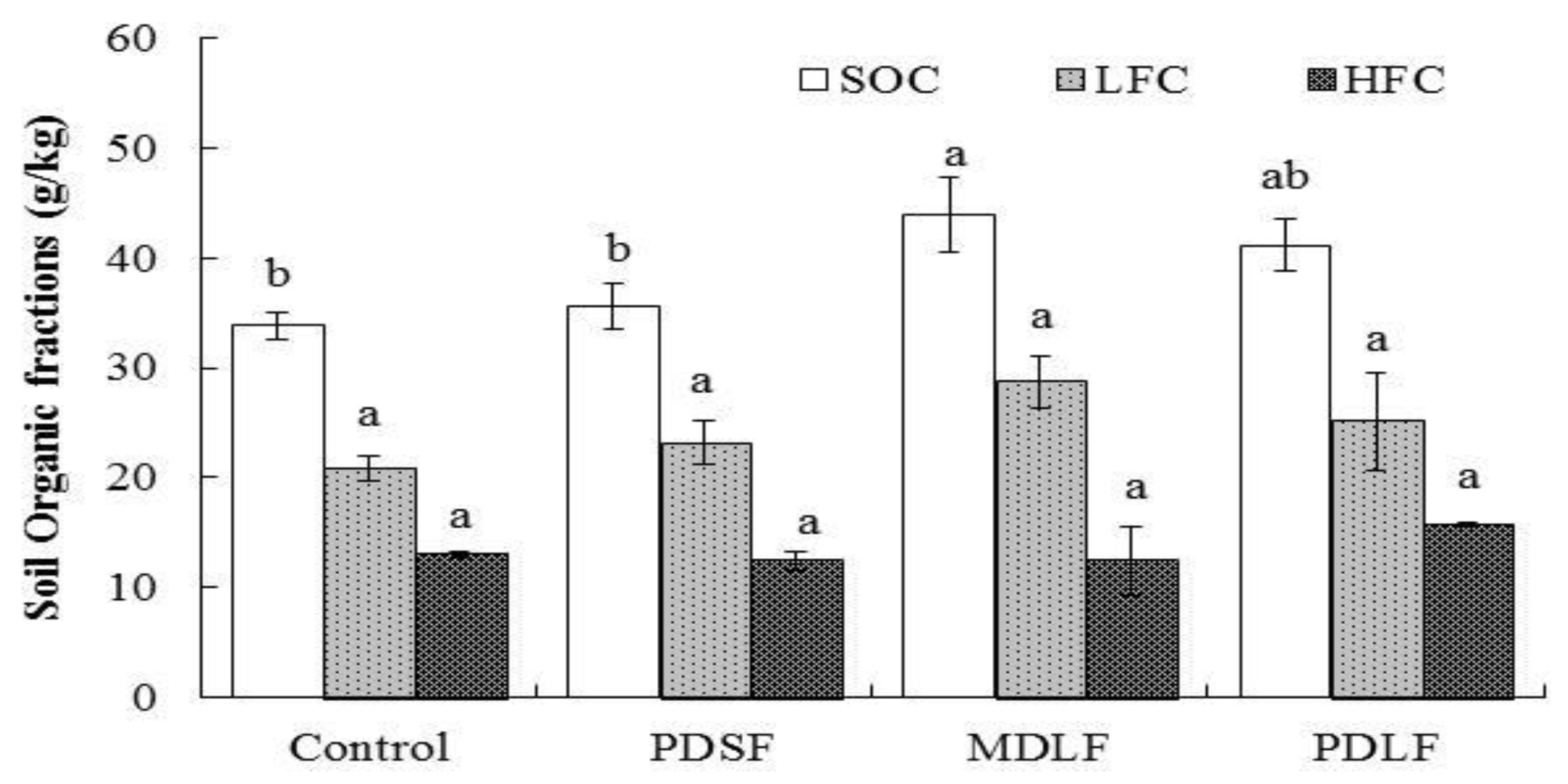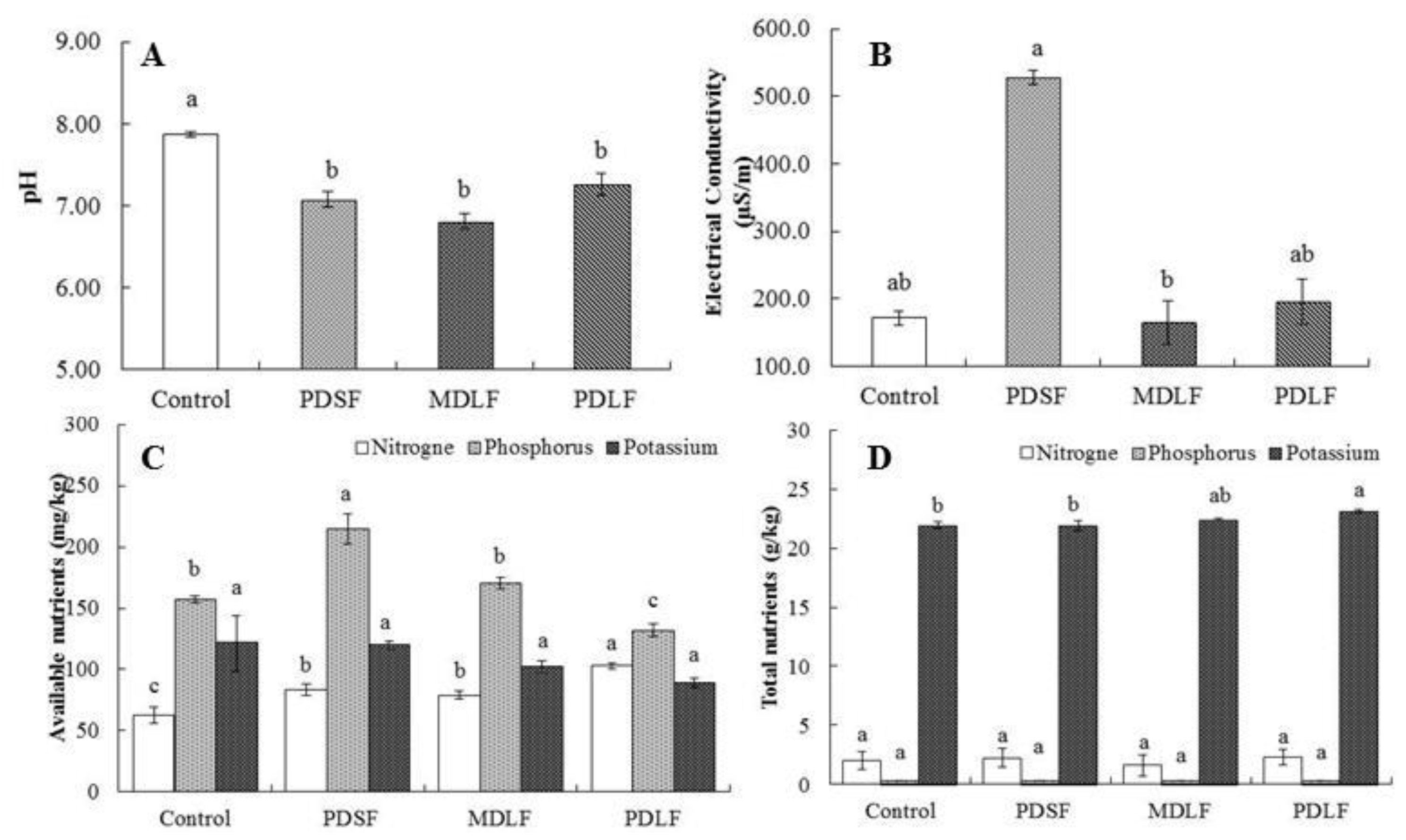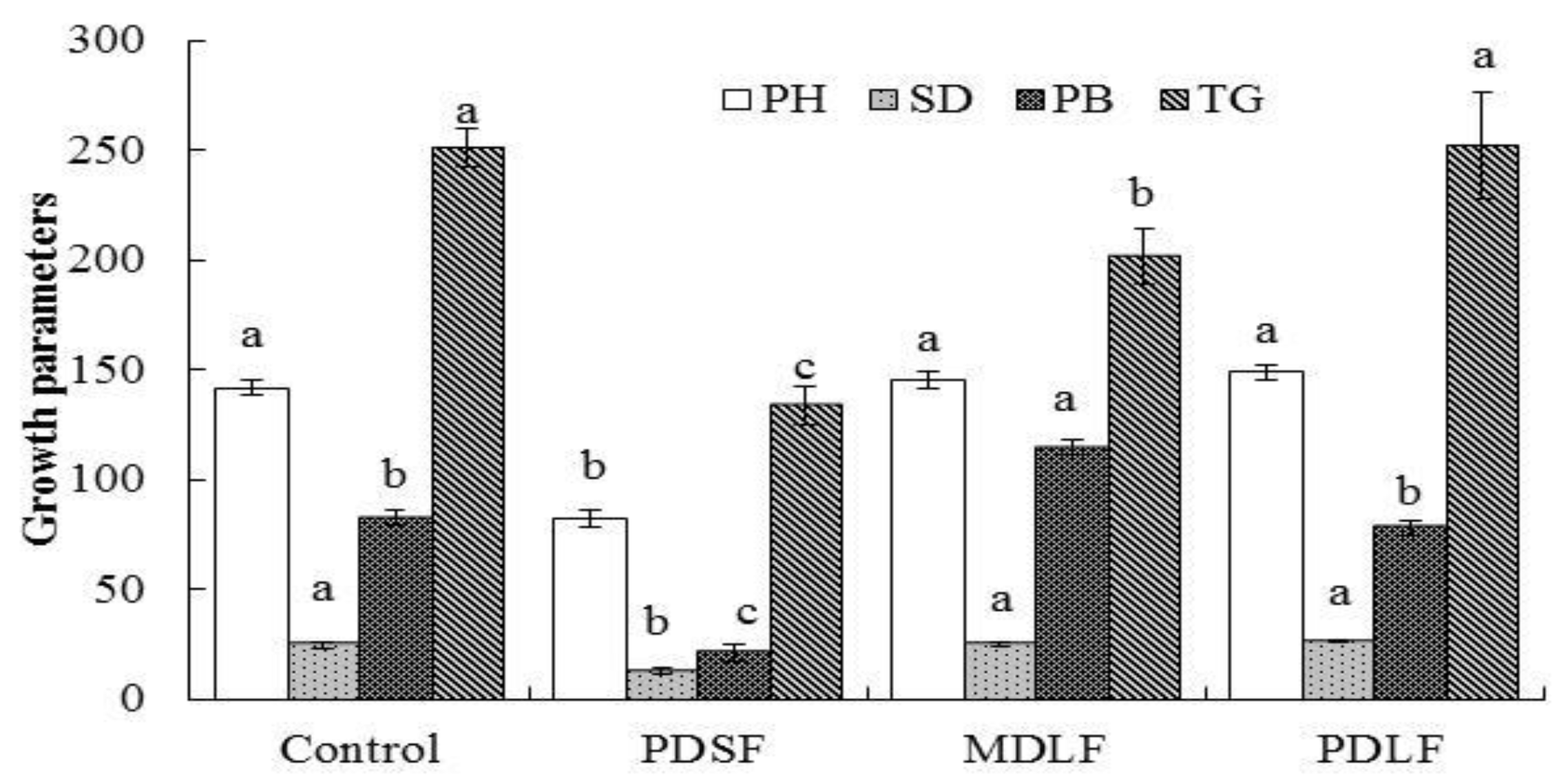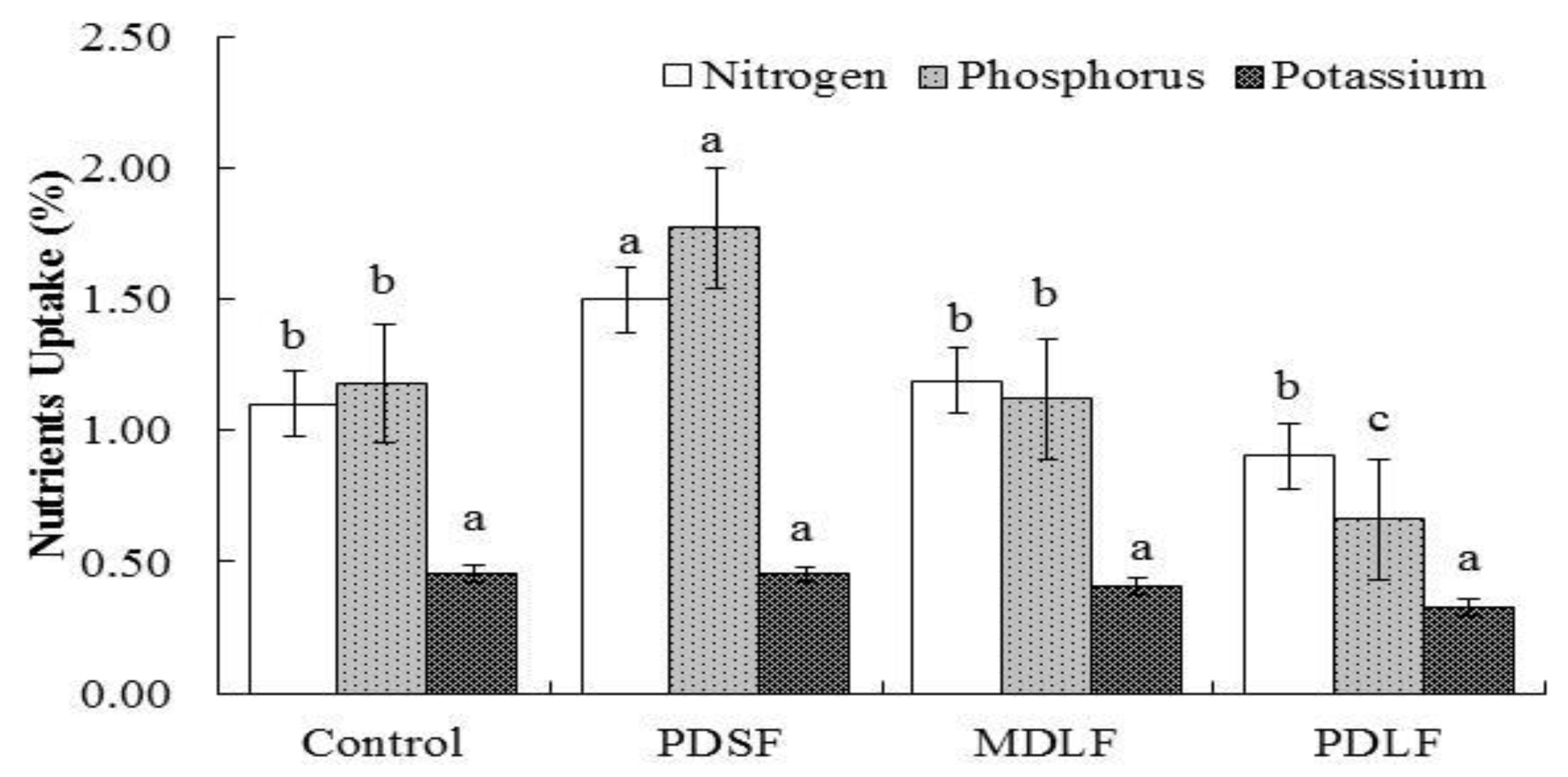The Effect of Fulvic Acids Derived from Different Materials on Changing Properties of Albic Black Soil in the Northeast Plain of China
Abstract
:1. Introduction
2. Results
2.1. Effect of Fulvic Acids (FA) on Soil Organic Carbon and its Labile Fractions
2.2. Effect of Fulvic Acids (FA) on Soil Chemical Properties
2.3. Effect of Fulvic Acids (FA) on Soil Exchangeable Ca and Mg, Organic–Inorganic Compound, and Organic–Inorganic Complexes
2.4. Effect of Fulvic Acids (FA) on Plant Growth Parameters
2.5. The Response of Fulvic Acids (FA) on Nutrient Uptake
3. Discussion
3.1. Effect of Fulvic Acid on Soil Organic Carbon and Organic–Inorganic Compounds
3.2. Effect of Fulvic Acids (FA) on Soil Fertility
3.3. Effect of Fulvic Acids (FA) on Plant Growth
4. Material and Methods
4.1. Experimental Soils and Fulvic Acids (FA)
4.2. Experimental Design
4.3. Organic–Inorganic Compound and Organic–Inorganic Composites Analysis
4.4. Calculation and Statistical Analysis
5. Conclusions
Author Contributions
Funding
Acknowledgments
Conflicts of Interest
References
- Han, X.Z.; Tang, C.; Song, C.Y.; Wang, S.Y.; Qiao, Y.F. Phosphorus characteristics correlate with soil fertility of albic luvisols. Plant Soil 2005, 270, 47–56. [Google Scholar] [CrossRef]
- Zhao, B.Z.; Zhang, J.B.; Flury, M.; Zhu, A.N.; Jiang, Q.A.; Bi, J.W. Groundwater contamination with no3-n in a wheat-corn cropping system in the North China plain (In Chinese with English abstract). Pedosphere 2007, 17, 721–731. [Google Scholar] [CrossRef]
- Wen, D.; Liang, W. Soil fertility quality and agricultural sustainable development in the black soil region of northeast China. Environ. Develop. Sustain. 2001, 3, 31–43. [Google Scholar] [CrossRef]
- Zhao, L.P.; Ma, J.; Yang, X.M. Composition and types of hummus in different particle fractions of arable albic soil (In Chinese with English abstract). Acta Pedol. Sin. 1997, 34, 28–41. [Google Scholar]
- Zhao, L.P.; Katsuhiro, L.; Minorn, Y. The composition of clay mineral in some main cultivated soil in Jilin Province (In Chinese with English abstract). Acta Pedol. Sin. 1993, 34, 267–273. [Google Scholar]
- Arjumend, T.; Abbasi, M.K.; Rafique, E. Effects of lignite-derived Humic acid on some selected soil properties, growth and nutrient uptake of wheat (Triticum aestivum L.) grown under greenhouse conditions. Pak. J. Bot. 2015, 47, 2231–2238. [Google Scholar]
- Robert, E.P. Organic matter, humus, humate, humic acid, fulvic acid and humin: Their importance in soil fertility and plant health. In Proceedings of the IEEE Geoscience and Remote Sensing Symposium (IGARSS) 2014, Quebec City, QC, Cananda, 13–18 July 2014; pp. 1–5. [Google Scholar]
- Sharif, M.; Khattak, R.A.; Sarir, M.S. Effect of different levels of lignitic coal derived humic acid on growth of maize plants. Commun. Soil Sci. Plant Anal. 2002, 33, 3567–3580. [Google Scholar] [CrossRef]
- Saruhan, V.; Kuşvuran, A.; Babat, S. The effect of different humic acid fertilization on yield and yield components performances of common millet (Panicum miliaceum L.). Sci. Res. Essays 2011, 6, 663–669. [Google Scholar]
- Daur, I.; Bakhashwain, A.A. Effect of humic acid on growth and quality of maize fodder production. Pak. J. Bot. 2013, 45, 21–25. [Google Scholar]
- Nardi, S.; Pizzeghello, D.; Muscolo, A.; Vianello, A. Physiological effects of humic substances on higher plants. Soil Biol. Biochem. 2002, 34, 1527–1536. [Google Scholar] [CrossRef]
- Eyheraguibel, B.; Silvestre, J.; Morard, P. Effects of humic substances derived from organic waste enhancement on the growth and mineral nutrition of maize. Bioresour. Technol. 2008, 99, 4206–4212. [Google Scholar] [CrossRef] [PubMed]
- Janzen, H.H.; Campbell, C.A.; Brandt, S.A.; Lafond, G.P.; Townley-Smith, L. Light-fraction organic matter in soils from long-term crop rotations. Soil Sci. Soc. Am. J. 1992, 56, 1799–1806. [Google Scholar] [CrossRef]
- Alvarez, C.R.; Alvarez, R.; Grigera, M.S.; Lavado, R.S. Associations between organic matter fractions and the active soil microbial biomass. Soil Biol. Biochem. 1998, 30, 767–773. [Google Scholar] [CrossRef]
- Haynes, R.J. Labile organic matter as an indicator of organic matter quality in arable and pastoral soils in New Zealand. Soil Biol. Biochem. 2000, 32, 211–219. [Google Scholar] [CrossRef]
- Golchin, A.; Clarke, P.; Oades, J.M.; Skjemstad, J.O. The effects of cultivation on the composition of organic matter and structural stability of soils. Aust. J. Soil Res. 1995, 33, 975–993. [Google Scholar] [CrossRef]
- Golchin, A.; Oades, J.M.; Skjemstad, J.O.; Clarke, P. Structural and dynamic properties of soil organic matter as reflected by 13C natural abundance, pyrolysis mass spectrometry and solid-state13c nmr spectroscopy in density fractions of an oxisol under forest and pasture. Aust. J. Soil Res. 1995, 33, 59–76. [Google Scholar] [CrossRef]
- Hassink, J. Density fractions of soil macroorganic matter and microbial biomass as predictors of C and N mineralization. Soil Biol. Biochem. 1995, 27, 1099–1108. [Google Scholar] [CrossRef]
- Wander, M.M.; Traina, S.J. Organic matter fractions from organically and conventionally managed soils: i. carbon and nitrogen distribution. Soil Sci. Soc. Am. J. 2010, 60, 1081–1087. [Google Scholar] [CrossRef]
- Barrios, E.; Buresh, R.J.; Sprent, J.I. Nitrogen mineralization in density fractions of soil organic matter from maize and legume cropping systems. Soil Biol. Biochem. 1996, 28, 1459–1465. [Google Scholar] [CrossRef]
- Whalen, J.K.; Bottomley, P.J.; Myrold, D.D. Carbon and nitrogen mineralization from light- and heavy-fraction additions to soil. Soil Biol. Biochem. 2000, 32, 1345–1352. [Google Scholar] [CrossRef]
- Rovira, P.; Casals, P.; Romanyà, J.; Bottner, P.; Coûteaux, M.M.; Ramon Vallejo, V. Recovery of fresh debris of different sizes in density fractions of two contrasting soils. Eur. J. Soil Biol. 1998, 34, 31–37. [Google Scholar] [CrossRef]
- Crow, S.E.; Swanston, C.W.; Lajtha, K.; Brooks, J.R.; Keirstead, H. Density fractionation of forest soils: Methodological questions and interpretation of incubation results and turnover time in an ecosystem context. Biogeochemistry 2007, 85, 69–90. [Google Scholar] [CrossRef]
- Von Lützow, M.; Kögel-Knabner, I.; Ekschmitt, K.; Flessa, H.; Guggenberger, G.; Matzner, E.; Marschner, B. SOM fractionation methods: Relevance to functional pools and to stabilization mechanisms. Soil Biol. Biochem. 2007, 39, 2183–2207. [Google Scholar] [CrossRef]
- Gong, W.; Yan, X.; Wang, J.; Hu, T.; Gong, Y. Long-term manure and fertilizer effects on soil organic matter fractions and microbes under a wheat-maize cropping system in northern China. Geoderma 2009, 149, 318–324. [Google Scholar] [CrossRef]
- Moody, P.W.; Aitken, R.L. Soil acidification under some tropical agricultural systems. Aust. J. Soil Res. 1997, 35, 163–173. [Google Scholar] [CrossRef]
- Mayhew, L. Humic substances in biological agriculture. Acres 2004, 34, 54–61. [Google Scholar]
- Piccolo, A.; Mbagwu, J.S.C. Role of hydrophobic components of soil organic matter in soil aggregate stability. Soil Sci. Soc. Am. J. 1999, 63, 1801–1810. [Google Scholar] [CrossRef]
- Tahir, M.M.; Khurshid, M.; Khan, M.Z.; Abbasi, M.K.; Kazmi, M.H. Lignite-derived humic acid effect on growth of wheat plants in different soils. Pedosphere 2011, 21, 124–131. [Google Scholar] [CrossRef]
- Singaram, P. Influence of humic acid application on yield, nutrient availability and uptake in tomato. Madaras Agric. J. 2005, 10, 670–676. [Google Scholar]
- Sibanda, H.M.; Young, S.D. Competitive adsorption of humus acids and phosphate on goethite, gibbsite and two tropical soils. J. Soil Sci. 1986, 37, 197–204. [Google Scholar] [CrossRef]
- Hua, Q.X.; Li, Y.J.; Zhou, J.M.; Wang, H.Y.; Du, C.W.; Chen, X.Q. Enhancement of phosphorus solubility by humic substances in ferrosols. Pedosphere 2008, 18, 533–538. [Google Scholar] [CrossRef]
- Du, Z.Y.; Wang, Q.H.; Liu, F.C.; Ma, H.L.; Ma, B.Y.; MalhI, S.S. Movement of phosphorus in a calcareous soil as affected by humic acid. Pedosphere 2013, 45, 21–25. [Google Scholar] [CrossRef]
- Liu, C.H.; Luo, L.; Du, L.Y. Effect of humic acids on fixation and release of potassium in cultivated brown soil (In Chinese with English abstract). Acta Pedology Sin. 2005, 42, 472–477. [Google Scholar]
- Khan, R.U.; Khan, M.Z.; Khan, A.; Saba, S.; Hussain, F.; Jan, I.U. Effect of humic acid on growth and crop nutrient status of wheat on two different soils. J. Plant Nutr. 2018, 41, 453–460. [Google Scholar] [CrossRef]
- Khaled, H.; Fawy, H.A. Effect of different levels of humic acids on the nutrient content, plant growth, and soil properties under conditions of salinity. Soil Water Res. 2011, 1, 21–29. [Google Scholar] [CrossRef]
- Delfine, S.; Tognetti, R.; Desiderio, E.; Alvino, A. Effect of foliar application of N and humic acids on growth and yield of durum wheat. Agron. Sustain. Dev. 2005, 25, 183–191. [Google Scholar] [CrossRef]
- Çelik, H.; Katkat, A.V.; Aşik, B.B.; Turan, M.A. Effect of foliar-applied humic acid to dry weight and mineral nutrient uptake of maize under calcareous soil conditions. Commun. Soil Sci. Plant Anal. 2011, 42, 29–38. [Google Scholar] [CrossRef]
- Canellas, L.P.; Teixeira, L.R.L.; Dobbss, L.B.; Silva, C.A.; Medici, L.O.; Zandonadi, D.B.; Façanha, A.R. Humic acids crossinteractions with root and organic acids. Annals Appl. Biol. 2008, 153, 157–166. [Google Scholar] [CrossRef]
- Sochan, A.; Bieganowski, A.; Ry, M.; Dobrowolski, R.; Bartmiñski, P. Comparison of soil texture determined by two dispersion units of mastersizer note. Int. Agrophys. 2012, 26, 99–102. [Google Scholar] [CrossRef]
- Parkinson, J.A.; Allen, S.E. A wet oxidation procedure suitable for the determination of nitrogen and mineral nutrients in biological material. Geochim. Cosmochim. Acta 1975, 53, 730–733. [Google Scholar] [CrossRef]
- Murphy, J.; Riley, J.P.A. Modified single solution method for the determination of phosphate in natural waters. Anal. Chim. Acta 1962, 27, 31–36. [Google Scholar] [CrossRef]
- Knudsen, D.; Peterson, G.A.; Prat, P.E. Lithium, sodium, and potassium. In Methods of Soil Analysis; Part 2; American Society of Agronomy: Madison, WI, USA, 1982; Volume 9, pp. 225–245. [Google Scholar]
- Six, J.; Elliott, E.T.; Paustian, K.; Doran, J.W. Aggregation and soil organic matter accumulation in cultivated and native grassland soils. Soil Sci. Soc. Am. J. 1998, 62, 1367. [Google Scholar] [CrossRef]
- Aanderud, Z.T.; Richards, J.H.; Svejcar, T.; James, J.J. A shift in seasonal rainfall reduces soil organic carbon storage in a cold desert. Ecosystems 2010, 1, 673–682. [Google Scholar] [CrossRef]
Sample Availability: Samples of the compounds are not available from the authors. |




| Treatments g/kg | Ca meq/L | Mg meq/L | Organic–Inorganic Degree Compound (%) | Organic–Inorganic Composite (g/kg) |
|---|---|---|---|---|
| Control | 240.1 ± 5.10 a | 26.7 ± 4.34 a | 32.55 ± 1.32 a | 1.09 ± 0.02 a |
| PDSF | 226.4 ± 22.6 a,b | 23.4 ± 0.25 a | 28.84 ± 1.24 a,b | 1.02 ± 0.01 b |
| MDLF | 248.3 ± 6.43 a | 21.1 ± 0.70 a | 26.77 ± 1.26 b | 1.08 ± 0.09 a |
| PDLF | 189.5 ± 17.25 b | 25.9 ± 0.83 a | 26.74 ± 1.40 b | 1.09 ± 0.01 a |
| Items | Value |
|---|---|
| Electrical conductivity µS/cm | 0.31 |
| pH | 7.88 |
| Soil Organic Carbon (g/kg) | 8.44 |
| Cation Exchange Capacity | 21.6 |
| Available Nitrogen (mg/kg) | 66.0 |
| Available Phosphorus (mg/kg) | 0.44 |
| Available Potassium (mg/kg) | 78.0 |
| Total Nitrogen (g/kg) | 0.70 |
| Total Phosphorus (g/kg) | 0.39 |
| Total Potassium (g/kg) | 19.3 |
| 2~0.2 mm | 10.89 |
| 0.2~0.02 mm | 33.46 |
| 0.02~0.002 mm | 28.69 |
| >0.002 mm | 26.95 |
| Texture Class | Silty Clay Loam |
| FA Type | N | C | H | S |
|---|---|---|---|---|
| % | ||||
| PDSF | 5.39 | 25.31 | 5.75 | 8.47 |
| MDLF | 10.29 | 52.476 | 9.74 | 14.84 |
| PDLF | 10.78 | 50.61 | 11.56 | 16.96 |
© 2019 by the authors. Licensee MDPI, Basel, Switzerland. This article is an open access article distributed under the terms and conditions of the Creative Commons Attribution (CC BY) license (http://creativecommons.org/licenses/by/4.0/).
Share and Cite
Kumar Sootahar, M.; Zeng, X.; Su, S.; Wang, Y.; Bai, L.; Zhang, Y.; Li, T.; Zhang, X. The Effect of Fulvic Acids Derived from Different Materials on Changing Properties of Albic Black Soil in the Northeast Plain of China. Molecules 2019, 24, 1535. https://doi.org/10.3390/molecules24081535
Kumar Sootahar M, Zeng X, Su S, Wang Y, Bai L, Zhang Y, Li T, Zhang X. The Effect of Fulvic Acids Derived from Different Materials on Changing Properties of Albic Black Soil in the Northeast Plain of China. Molecules. 2019; 24(8):1535. https://doi.org/10.3390/molecules24081535
Chicago/Turabian StyleKumar Sootahar, Mahendar, Xibai Zeng, Shiming Su, Yanan Wang, Lingyu Bai, Yang Zhang, Tao Li, and Xiaojia Zhang. 2019. "The Effect of Fulvic Acids Derived from Different Materials on Changing Properties of Albic Black Soil in the Northeast Plain of China" Molecules 24, no. 8: 1535. https://doi.org/10.3390/molecules24081535






